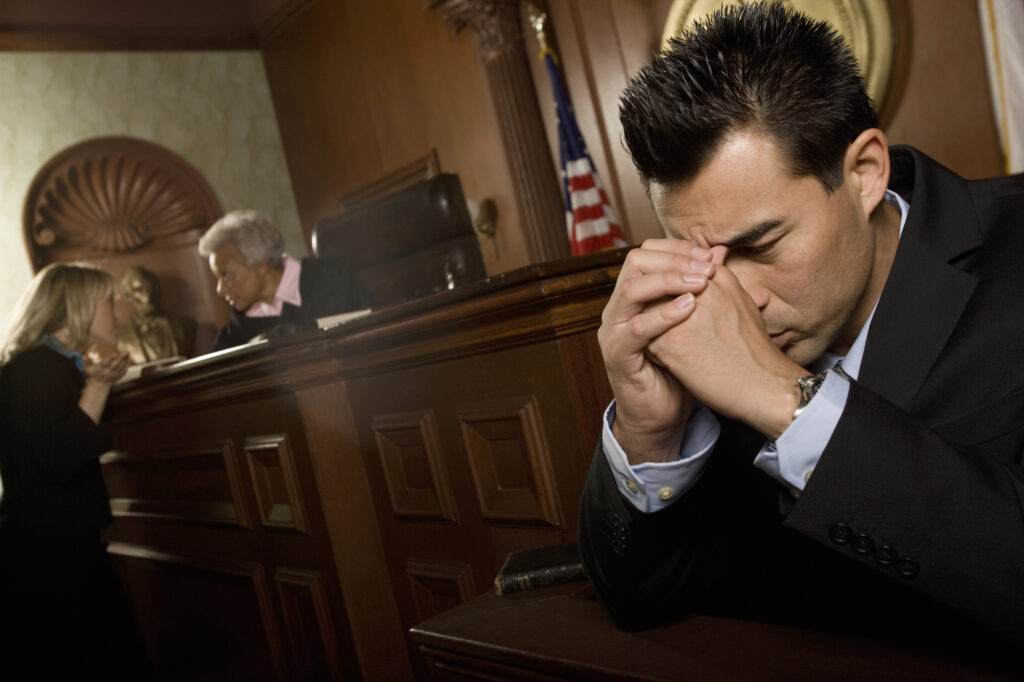Understanding the genre of legal thrillers
Legal thrillers are a subgenre of fiction that focuses on crimes, courtroom scenes, and the legal system in general.
These novels feature protagonists who work in the legal field, such as lawyers, judges, or jurors.
The stakes are high, making for compelling storytelling. And the stories revolve around the pursuit of justice, usually with surprising twists and turns.
How to write a believable legal thriller
It’s essential to have a solid understanding of the legal system to write a successful, believable legal thriller. Indeed, research is critical.
So, those already familiar with legal terminology, court procedures, and criminal law are at an advantage.
Of course:
Most people who read legal thrillers are not lawyers, so the art of the successful legal thriller writer is to make the legal aspects accessible to the layman, helping build a realistic and believable world for your readers to immerse themselves in.
Crafting believable characters
One of the most important aspects of a legal thriller is the characters.
So, to make your story compelling, it is crucial to create believable characters with:
- Skills — What is their particular skill that few other people have? Maybe they have a knack for knowing when someone’s lying. Perhaps they have a passion for forensic research.
- Misbehaviors — This is what makes them a maverick. It’s what gets the job done but gets them in trouble.
- Fatal flaws — Something from their past that continually threatens to expose itself.
- A shadow — somebody lurking on the down-low who knows about their fatal flaw.
Give your characters a world
Lawyers, judges, and other legal professionals come from diverse backgrounds and have different motivations, strengths, and flaws. Reflecting this diversity in your characters adds depth and complexity to your story.
Remember: it’s best to avoid clichés and stereotypes when developing your characters.
Break away from the archetypal alcoholic cop or the Atticus Finch-like defender of the innocent. We’ve seen that before.
Instead, portray your characters as multidimensional individuals with good and bad qualities. This will make them more relatable and realistic.
Don’t forget their personal life. Readers want to see protagonists with partners and/or families. Sometimes those relationships are rocky, but they’re there to balance out their personalities.
Getting the law right
Accuracy is paramount when writing a legal thriller. Your readers expect your portrayal of the legal system to be authentic and true to life.
So, before making legal arguments in your story, conduct thorough research to understand the relevant laws and legal precedents.
Research real-life court cases and judicial decisions to inform your writing. Of course, it’s always best to write what you know.
This will help you accurately depict courtroom procedures, evidence admissibility, and different legal professionals’ roles. And by getting the law right, you’ll enhance the credibility of your story and keep your readers engaged.
Creating realistic courtroom scenes
Courtroom scenes are the heart of a legal thriller. They provide opportunities for drama, tension, and conflict. But when writing courtroom scenes, it’s critical to strike the right balance between realism and entertainment.
While some creative liberties can be taken to heighten the suspense, it is crucial to maintain believability.
Use your knowledge of the look and feel of actual courtroom proceedings. Understand the layout of the courtroom, the positions of the lawyers, judges, and witnesses, and the use of technology. Being a practising lawyer means you’re at home in your story’s principal location.
By accurately depicting the courtroom dynamics you know so well, you will immerse readers in the world of your legal thriller.
Conveying the exhaustion of trials
Trials can be physically and mentally exhausting for all involved parties.
While television shows and movies condense trials into short, riveting sequences, as you know, real-life trials can last for days, weeks, or even months. Witnesses often find themselves on the stand for extended periods, and you’ll know for yourself that not every moment of testimony is riveting.
So, while avoiding the tedium of the “admin”, don’t forget that time plays a significant role in building tension. You don’t want to bore your audience with the minute details, but you might want to express the exhaustion you or your clients might feel mid-trial. Lowlight the tedium and moments of boredom and highlight the moments of high tension.
Show the impact of the lengthy trial on the participants, including jurors, lawyers, and even the judge. By accurately portraying the fatigue and emotional strain of trials, you will create a more authentic and engaging reading experience.
Understanding motivations
In a legal thriller, motivations play a crucial role in driving the actions and decisions of your characters. Everyone involved, from the prosecutor to the defence lawyer and the accused, has their own justifications for their actions.
So, part of the fun of building a web of intrigue is exploring the complexities of your characters’ motivations and beliefs, even if they seem morally ambiguous.
Even the guilty party in your story should have their reasons for their actions, even if they go against societal norms. Dive into their mindset, exploring their internal justifications and perspectives.
Additionally, consider the ethical dilemmas the lawyers face, who may grapple with conflicting duties and personal beliefs. By delving into your characters’ motivations, you will add depth and complexity to your legal thriller.
Crafting compelling plots
Legal thrillers offer an opportunity to build gripping plots set against the clock.
The trial itself can serve as a powerful plot device, as the protagonist races against time to uncover the truth or prevent an unjust verdict. This can bring your characters outside of the courtroom into investigative mode.
The higher the stakes and the more pressing the moral complexities, the more potential for suspense and tension.
Be daring with your plotlines
Consider incorporating legal issues that are relevant and thought-provoking. Explore grey areas of the law where right and wrong may not be clear-cut.
Develop intricate plots that keep readers guessing and engaged until the very end. Crafting compelling plots will keep readers on the edge of their seats.
However, you might feel that building the plot is the hardest part. In this case, a ghostwriting opportunity, where the plot is laid out for you, could be the opportunity you’re looking for to get into print.
Alternatives to courtroom scenes
While courtroom scenes are a staple of legal thrillers, they are not the only way to create a compelling story. You can explore alternative approaches that still capture the essence of the legal world.
For example, your plot could build a case from the first client meeting, using flashbacks to fill in your client’s or the accused’s story. Maybe the client isn’t telling the whole truth; perhaps the accused is a particularly slippery character.
Or you could tell the story from the perspective of a jury member, expressing differing viewpoints and speculating on the outcome of a trial. This can create suspense and intrigue without the need for actual courtroom scenes.
Different angles on a courtroom case
Alternatively, you might focus on the aftermath of a trial, exploring the impact of a verdict on the characters’ lives. This can provide an opportunity to delve into the emotional and psychological consequences of legal battles.
Remember: You can craft a unique and engaging legal thriller by thinking creatively and exploring different narrative angles.
Mastering the art of suspense
Suspense is a crucial element of any thriller. Keep the reader hooked with contrasts in pace, cunningly placed cliffhangers, and unexpected twists to maintain tension and create anticipation.
Carefully structure your story to reveal the information gradually, keeping readers guessing and eager for more.
Consider the use of foreshadowing and subtle clues to hint at future developments. By skillfully managing suspense, you will ensure that readers are invested in your legal thriller from start to finish.
Incorporating emotional depth
While legal thrillers are often driven by the pursuit of justice and conflict resolution, infusing emotional depth is essential to ensure your story is relatable.
Explore the personal lives and motivations of your characters beyond their legal roles. Show how their actions and decisions in the courtroom impact their relationships and emotional well-being.
Ensure readers can connect with your characters on an emotional level. Develop their backstories, fears, and aspirations. By incorporating emotional depth, you will create a more immersive reading experience and evoke empathy from your audience.
Showcasing the complexity of the legal system
You know from your experience that the legal system is complex and multifaceted. So, use your legal expertise to showcase the intricacies of the legal world in your writing.
Highlight the nuances of the law, exploit legal loopholes, and incorporate the challenges lawyers face. Explore the impact of legal decisions on individuals and society.
Explore the ethical dilemmas and moral grey areas that lawyers often encounter. Discuss the tension between following the letter of the law and pursuing justice.
By delving into the legal system’s complexity, you will elevate your legal thriller and provide readers with a deeper understanding of the legal world.
The power of research
Research is fundamental when writing a realistic and compelling legal thriller. Dive deep into legal precedents, real-life court cases, and legal procedures. Understand the intricacies of the law and the roles of different legal professionals. Incorporate accurate legal terminology and courtroom dynamics into your writing, but don’t forget that you’ll need to debunk some jargon for your readers.
Consult reputable sources, such as legal textbooks, legal journals, and real-life court cases. Take the time to comprehend the intricacies of the legal issues at the heart of your story. And by conducting thorough research, you will enhance the authenticity and credibility of your legal thriller.
Perfecting your writing craft
Writing a legal thriller requires legal knowledge and strong writing skills. Hone your craft by reading widely within the genre and studying the techniques employed by successful legal thriller authors. Pay attention to pacing, character development, dialogue, and plot structure.
Join writing communities or workshops to share your work and receive feedback and guidance from fellow writers.
And remember: writing is rewriting. Polish your writing through revisions and edits, ensuring your prose is clear, engaging, and error-free.
By continuously striving to improve your writing skills, you will create a legal thriller that captivates readers and stands out in the genre.
Relay Publishing wants to hear from you!
Are you a legal professional? Do you dream of becoming a writer? Well, the path to authorship isn’t as far away as you might think. There’s a high demand for writers with legal experience who can bring finesse and knowledge to the page.
By leveraging your legal experience and following these tips, you can create a gripping story that combines the intricacies of the law with suspenseful storytelling.
But don’t worry if you don’t have direct experience; Relay Publishing has plenty of ghostwriting opportunities, and we’re here to help you realize your dream of becoming an author of legal thrillers.
We’re looking to expand our existing legal thriller portfolio. Are you ready to work with our editors to develop compelling legal thrillers for a keen readership?
Get in touch — we’d love to hear from you. Find out more about our legal thriller opportunities.
Thanks for reading.




